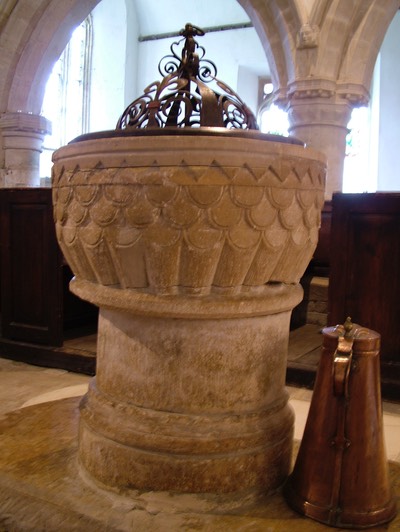The Norman Font

The earliest feature of the church is the circular Norman font, the lower part of which is formed like a scallop-capital with fish-scale ornamentation above.
The north aisle, which is filled with Georgian box pews, is a 14th century copy of Norman work. The arches of the nave rest on the round columns which have sculptured capitals, all of them different. Here is a fine array of thirty or forty figures and faces below the roof and on the arches. Most are human, with a few grotesques. Some of them are corbels holding up the roof.
The bench table (stone bench) on the inside of the north wall is of particular interest and probably dates from the 13th century.
Most of the ancient glass was destroyed by Cromwell's men in the Fanatique Tymes, as John Aubrey put it, but some fragmentary pieces remain in the north aisle windows, mainly heraldic forms. They show Royal Arms, Scrope, Badlesmere, Dunstanville and Paulet among others. The families represented were all at one time or another associated with the Manor of Castle Combe though the Paulet arms occur all over South and West England.
The 14th century aisle terminated in a line with the chancel arch. When the aisle was lengthened, the original three-light east window with reticulated tracery was reconstructed in the present 15th century east wall, and the square-headed three-light windows inserted in the north wall, and two in the south wall of the nave.
The Royal Arms over the chancel arch, which by law after the Restoration had to be displayed, is interesting as it is in the form used by the Georges until 1801. These were the last of the Royal Arms to display the Arms of France in the second quarter.
The pulpit is of stone, with 15th century stone carving. The stone steps up to it are 600 years old.
The altar is crowned with a late nineteenth century reredos, which is a Doulton terracotta panel of the Last Supper by George Tinworth. The altar rails are 17th century with vertically symmetrical balusters. There is a heraldic wall monument beside the altar with marks of lightning on it, to Samuel Arnold a 19th century rector for 40 years. Some restoration work was carried out in 1900 and again in the 1970s when a serious fire destroyed much of the work just finished. Repairs were again completed a year later.
The church possesses several pieces of silver, including a flagon, chalice, paten and paten cover, most of which dates from the 17th and 18th century.
WAR MEMORIALS
The Church has memorials for two World Wars, and there is the war grave of Edwin Kent in the churchyard. John Belcher of Chippenham has researched the details and produced a marvellous document - click here: Nettleton Memorial.pdf. The Church also has First World War Rolls of Honour for the Parish and for Nettleton School.